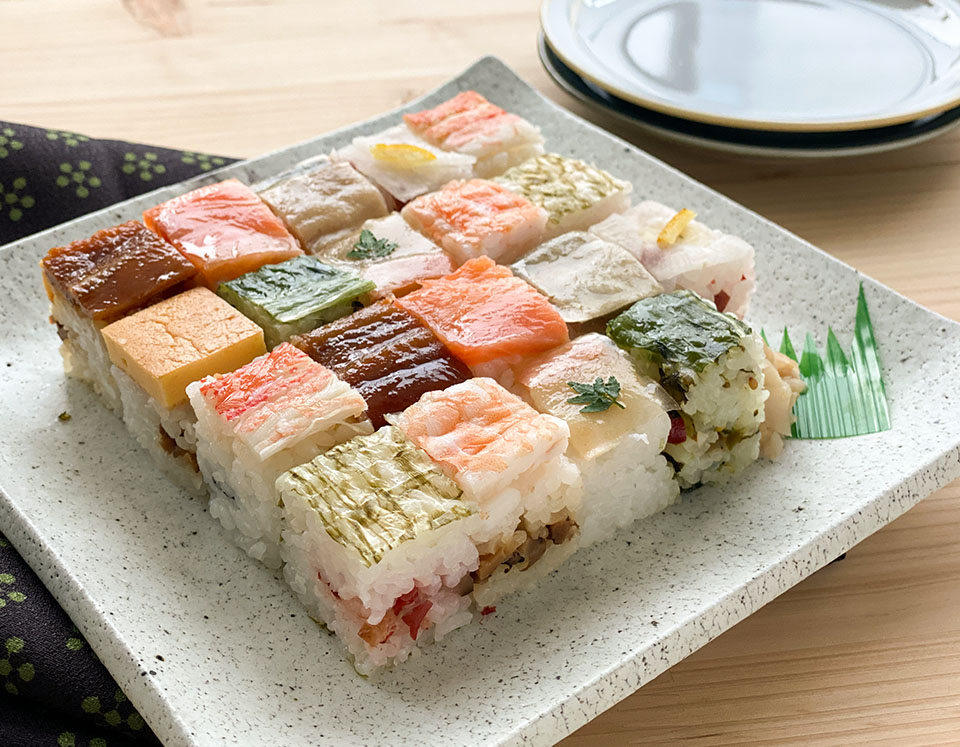When photographing Hako-Zushi, renowned for its colorful array, aspects like lighting and angle become pivotal points. Utilize natural light and explore angles that highlight the beauty of the ingredients, as well as framing that complements them. The most crucial aspect to be mindful of is devising ways to ensure the ingredients appear vividly. In this instance, we introduce photography methods that accentuate the allure of Hako-Zushi.
Oshi-Zushi or Hako-Zushi?
Oshi-Zushi is a form of traditional Japanese sushi, which, as the name implies, is made by pressing rice and ingredients into layers using a wooden box or a specialized mold (pressing mold).
Ingredients such as fish, shrimp, and vegetables are used, and each layer possesses beautiful colors, making it a dish that can be enjoyed visually as well.
This type of pressed sushi is referred to as “Hako-Zushi” in Osaka and Kyoto. Osaka’s Hako-Zushi emphasizes vibrant colors by using a variety of ingredients. Kyoto’s Hako-Zushi is characterized by layers of tuna, shiitake mushrooms, and tamagoyaki (Japanese omelette), and the sushi rice is mixed with white sesame seeds.
Indeed, Japan boasts a variety of sushi styles, each with its unique preparation method and presentation:
 Nigiri-Zushi: Small balls of vinegared rice topped with fresh fish, shellfish, or other ingredients, often with a dab of wasabi.
Nigiri-Zushi: Small balls of vinegared rice topped with fresh fish, shellfish, or other ingredients, often with a dab of wasabi. Oshi-Zushi(Hako-Zushi): Rice and ingredients are pressed into a mold to create a layered, rectangular block, which is then cut into bite-sized pieces.
Oshi-Zushi(Hako-Zushi): Rice and ingredients are pressed into a mold to create a layered, rectangular block, which is then cut into bite-sized pieces. Maki-Zushi: Rice and various fillings are rolled inside a seaweed sheet (nori) and then sliced into rounds.
Maki-Zushi: Rice and various fillings are rolled inside a seaweed sheet (nori) and then sliced into rounds. Chirashi-Zushi: A bowl of sushi rice topped with a variety of sashimi and other ingredients, often including vegetables, scrambled eggs, and shiitake mushrooms.
Chirashi-Zushi: A bowl of sushi rice topped with a variety of sashimi and other ingredients, often including vegetables, scrambled eggs, and shiitake mushrooms. Kakinoha-Zushi: Sushi rice and toppings (often mackerel or salmon) are wrapped in persimmon leaves, imparting a subtle flavor.
Kakinoha-Zushi: Sushi rice and toppings (often mackerel or salmon) are wrapped in persimmon leaves, imparting a subtle flavor. Temari-Zushi: Small, ball-shaped sushi topped with colorful ingredients, resembling temari (handballs used in traditional Japanese games).
Temari-Zushi: Small, ball-shaped sushi topped with colorful ingredients, resembling temari (handballs used in traditional Japanese games).Each style offers a unique sushi-eating experience, showcasing the versatility and artistry found in Japanese cuisine.
POINT.1 Verify the Front and Angle of the Subject
As has been mentioned several times, Japanese cuisine invariably has a designated “front.”
In the case of a colorful subject like the boxed sushi we’re discussing, accurately capturing the front becomes crucial.


Determine the front by checking the direction of yuzu peels and tree buds.
Next is the angle. When the dish itself has some height, the way it shines in photos can significantly change with different angles, such as low, high, and overhead.
 Low Angle
Low Angle High Angle
High Angle Overhead Angle
Overhead AngleHako sushi photographed from a high angle or a true top-down perspective.
POINT.2 Adjust the Reflection of the Ingredients
To beautifully capture the vibrant colors of Hako-Zushi in a photo, ensure that there is a moderate reflection on the ingredients by checking the direction of the light and the arrangement of the subject.
Also, try using a serving plate as an accent, and experiment with compositions and framing that further emphasize the main star, the Hako-Zushi.
 Backlight
Backlight Right Side Light
Right Side LightHere’s a shot where the colors of the hako zushi are enhanced by the lighting.
POINT.3 Create a Sense of Three-Dimensionality
Lastly, for a subject with three-dimensionality like hako zushi, choosing an angle that highlights its side can further emphasize its colors and three-dimensional feel.
For instance, taking the sushi out of the wooden box and arranging it on a plate can result in a photo that makes it look like an entirely different dish.


A shot emphasizing the side
A shot that subtly showcases the side and is optimized
The video is available on YouTube
Regarding the techniques for photographing Hako-Zushi, I am also broadcasting them on YouTube videos, so please be sure to check them out.
*Don’t worry, it has English subtitles.








